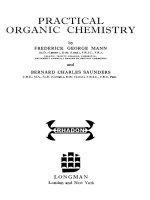Organic Chemistry
Bạn đang xem bản rút gọn của tài liệu. Xem và tải ngay bản đầy đủ của tài liệu tại đây (271.68 KB, 27 trang )
Organic Chemistry
Course Number: PCH 1120-217
Lecture # 8
Tuesday September 24, 2013
Geometric Isomerism in Cyclic Compounds &
Alkenes, and Conformations of Open-Chain
Compounds
Prof. Oludotun A. Phillips
Room # 2-81, 2nd Floor Pharmacy Building
Email:
Tel: 24986070
Learning Objectives
At the end of the class students should be able to:
describe geometric isomerism.
identify and assign configuration of geometric isomers
in alkenes and cyclic compounds (cis / trans
designations).
assign configuration of geometric isomers (E / Z
nomenclature) using the sequence rules.
discuss conformation in open-chain compounds.
Geometric Isomerism in cyclic compounds and alkenes
Geometric Isomerism: Results from rigidity, due to
restricted rotation in molecules.
It occurs in two classes of compounds, namely, the
Alkenes and Cyclic Compounds.
Generally, the atoms and groups in molecules that are
attached to single bonds (sigma bonds) can rotate
such that the molecular structure is in a state of
continuous change.
However, atoms or groups attached to a double bond
cannot rotate around the C=C double bond without
the pi bond being broken.
Geometric Isomerism in cyclic compounds and alkenes
H
H
H
C
C
Cl
Cl
H
H
Cl
H
C
OR
C
sigma (single bond) bond
free rotation
double bond
restricted rotation
pi orbitals
H
C
Cl
H
Cl
H
is different
from
C
Cl
(A)
Chloro atoms
groups are
on same side of db
Cl
C
C
Cl
H
(B)
groups are
Chloro atoms
on opposite sides of db
The double bonds are rigid hence the chloro groups attached to the
sp2-hybridized carbons are fixed in relation to one another.
Therefore, molecule (A) is not readily inter-convertible with molecule (B).
Geometric Isomerism in cyclic compounds and alkenes
The molecule is designated as cis (Latin, “on the side”)
when the two groups are on the same side of the double
bond (pi-bond).
The molecule is designated as trans (Latin, “across”)
when the two groups are on opposite sides of the double
bond (pi-bond).
The cis or trans designation is therefore incorporated into the
Nomenclature as italized Prefix:
H
C
Cl
H
H
(A)
C
is different from
C
Cl
cis-1,2-Dichloroethene
bp 60 oC
Cl
Cl
C
(B)
H
trans-1,2-Dichloroethene
bp 48 oC
Geometric Isomerism in cyclic compounds and alkenes
cis or trans stereoisomers are two different compounds,
having different physical properties, such as b.p, m.p etc
They are classified as “Stereoisomers” because they
differ in the arrangement of the atoms in space, and
belong to the specific category of “Geometric Isomers”
(designated: cis-trans isomers).
Geometric Isomers: are Stereoisomers that differ by
groups being on the same side or opposite sides in a
rigid molecule.
Geometric Isomerism cis or trans Designation
A requirement for Geometric Isomerism in Alkenes is
that each Carbon Atom involved in the pi bond (double
bond) have Two different groups attached to it, such
as H and Cl or CH3 and Cl.
H3C
H3C
CH2CH3
C
C
H
is Diffrent from
H
cis-2-pentene
Cl
H
C
C
H
cis-1-chloropropene
CH2CH3
H
CH3
C
is Diffrent from
H
C
trans-2-pentene
CH3
C
H
Cl
C
H
trans-1-chloropropene
Geometric Isomerism cis or trans Designation
However, if one of the Carbon atoms of the double
bond has two identical groups, such as two H atoms, or
two CH3 groups, geometric isomerism is not possible.
e.g. the following molecules are not Geometric Isomers:
H
C
C
H
is Same as
Cl
Cl
C
is Same as
CH2CH3
Cl
C
C
H
CH2CH3
H
CH2CH3
C
H
H
CH2CH3
CH2CH3
C
Cl
C
CH2CH3
Geometric Isomerism E / Z System of Nomenclature
The cis/trans designation becomes somewhat difficult to
assign when there are Three or Four Different Groups
attached to the Carbon Atoms of a Double Bond: e.g.
Br
F
C
I
C
Cl
In the structure above, we can say that Br and Cl are
trans to each other or that I and Cl are cis to each other.
It is difficult to designate the structure as either cis
or trans isomer.
To resolve this ambiguity, the E / Z System of
Nomenclature is used.
Geometric Isomerism E / Z System of Nomenclature
The E / Z System of assigning the configuration of an
isomer is based on Assignment of priorities to the
atoms or groups attached to each Carbon of the
Double Bond.
The Isomer is (E) if the Higher-priority Atoms or
Groups are on Opposite Side of the Double Bond.
While the Isomer is (Z) if the Higher-priority Atoms or
Groups are on the Same Side of the Double Bond.
The Letter (E) is from the German word entgegen,
(“across”); and (Z) is from the German zusammen,
(“together”).
Geometric Isomerism E / Z System of Nomenclature
Priority is based on the Atomic Numbers of the Atoms
directly attached to the Double Bond carbons.
Atoms with the Higher Atomic Number receives the
Higher Priority:
Br
F
I higher priority
than Br
Atom:
Atomic Number:
Br
F
C
I
F
9
C
I
Cl higher priority
than F
C
Cl
Cl
Br
17
35
Increasing Priority
I
53
Br
C
Cl
C
Cl
(Z)-1-Bromo-2-chloro2-fluoro-1-iodoethene
I
C
F
(E)-1-Bromo-2-chloro2-fluoro-1-iodoethene
Sequence Rules in Geometric Isomerism E / Z System
Note! that the Determination of Priorities by Atomic
Number alone cannot resolve / handle all the cases
encountered in Organic Chemistry.
H3C
For e.g. for naming:
CH3
C
CH3CH2
C
H
Priority Order can be determined using the “Sequence
Rules”
according
to
the
Cahn-Ingold-Prelog
Nomenclature System (discussed under the R/S
System of Nomenclature)
Sequence Rules in Geometric Isomerism E / Z System
“Sequence Rules” for Order of group priority:
1. for Atoms and group of atoms:
Atom:
Atomic Number:
F
9
Cl
17
Br
35
I
53
Increasing Priority
Atom No:
Atoms:
(1)
(6)
(7)
(8)
(16)
(17)
(35)
(53)
-H
-CH3
-N H2
- OH
- SH
- Cl
- Br
-I
Increasing priority
2.
for Isotopes:
Isotope:
1
1H or H
hydrogen
2
1H
or D
deuterium
Sequence Rules in Geometric Isomerism E / Z System
“Sequence Rules” for Order of group priority:
3. if Atoms are identical, the Atomic Number of the Next Atoms
are used for Priority Assignment:
Three H's:
lower priority
H
H
H3C
CH3
C
H
C
CH3CH2
H
H
(E)-3-Methyl-2-petene
-pentene
H3CH2C
CH2CH2CH2Cl
C
CH3
C
CH3
C
H
C
H
H
C
C
H
H
Two H's and One C: gives
this group the higher priority
Two H's and One C: gives
this group the higher priority
C
CH2CH2CH3
(Z)-isomer
(Z)-7-Chloro-4-propyl-3-methylhept-3-ene
Sequence Rules in Geometric Isomerism E / Z System
“Sequence Rules” for Order of group priority:
4. Atoms attached by double bond or triple bond are given
single bond equivalencies:
O
O
-CH=CR2
<
<
<
<
-CN
<<
-CH2OH
<<
C H
<
<
O
<
C
O
C OH
<
<
C OR
increasing priority
Structure
Equivalent for
priority determination
C
R
Is
same
as
R
C
R
Equivalent for
priority determination
O
O
O
O
R
Structure
R
C
OH
Is
same
as
R
R
C
N
O
OR
Is
same
as
R
C
O
OH
O
O
O
C
OR
R
C
Is
N same
as
R
C
N
N
Geometric Isomerism in cyclic compounds
Cis-trans isomers occur in cyclic compounds having:
the same molecular formula
the same connectivity of their atoms
an arrangement of atoms in space that cannot be
inter-converted by rotation about sigma bonds
Geometric Isomerism in Unsaturated cyclic compounds
configuration of the double bond in cyclopropene (3member ring) through cycloheptene (7-member ring)
must be “cis”; these rings are not large enough to
accommodate a “trans” double bond - due to ring strain
CH3
CH3
CH3
CH3
Cyclopentene
Cyclohexene derivative
Cyclooctene (8-member ring) is the smallest cycloalkene
that can accommodate a trans double bond:
t ra ns - Cy clo octe n e
ci s -Cycl oo cte n e
Geometric Isomerism in Saturated cyclic compounds
In Cyclopentanes (5-membered ring hydrocarbon)
Dashed line represents groups or atoms Below the Plane of
the Ring in the molecule
Solid line represents groups or atoms Above the Plane of the
Ring in the molecule
Geometric Isomerism in Saturated cyclic compounds
In Cyclohexanes (6-membered ring hydrocarbon):
Cyclohexanes may be viewed as planar hexagons
H
H3 C
CH3
H
CH3
H3 C
t ra ns-1,4-D i me th yl c ycl o he xan e
H
H3 C
H
CH3
H3 C
ci s-1,4-D i m e thy l cy cl o he xane
CH3
Conformation of open-chain compounds.
In Open-Chain Compounds, atoms or groups attached
by Sigma Bonds can Rotate around these bonds.
Hence the atoms or group can assume an Infinite
Number of Positions in Space Relative to one another.
Conformation: any three-dimensional arrangement of atoms
in a molecule that results from rotation about a single bond.
Because of Rotation around the Sigma Bonds, a
Molecule can assume any number of Conformations.
Conformation of open-chain compounds.
Conformations can be represented in following Types of
Formulas e.g. for Ethane:
(dash & wedge)
Formulas
(i)
and
(v)
are
representations of the molecule.
3-Dimensional
Newman projection (iii) is an end-on view of only Two
Carbon Atoms in the molecule. The bond joining the two
carbon is not visible.
Conformation of open-chain compounds.
Conformers: are different structures formed by Bond Rotations.
1.
Staggered conformation: a conformation about a carbon-carbon
single bond where the atoms on one carbon are as far apart as
possible from the atoms on an adjacent carbon: (is the most
stable and lowest energy conformation)
Conformation of open-chain compounds.
2.
Eclipsed conformation: a conformation about a carbon-carbon
single bond in which the atoms on one carbon are as close as
possible to the atoms on an adjacent carbon - least stable conformer
(highest energy)
.NOTE!! the lowest energy conformation of an alkane is a fully
staggered conformation:
Conformation of open-chain compounds.
Rotation of the groups around the carbon-2 and carbon-3 of
Butane – CH3CH2CH2CH3 will give the following conformers:
CH3
H
H
H
H
H
CH3
H
H
H3C
CH3
Staggered conformation
"anti" conformer
lowest energy - most stable
CH3
H
Eclipsed
H3C CH3
H
H3C
H
H
H
Gauched conformation
H
H
H
H
Eclipsed methyls
highest energy - least stable
Conformer Potentials of Butane about the Central C-C Bond









